Introduction
Welcome to the ultimate guide for anyone looking to elevate their furniture game! If you’ve ever stared at a chair and thought, “Why do these legs look like they belong in a different decade?” then you’re in the right place. Mixing and matching furniture legs, whether they are table legs, chair legs, or even sofa legs, can transform your space from drab to fab faster than you can say “custom furniture legs.”
In this guide, we’ll dive into the nitty-gritty of choosing the right materials, whether it’s sleek metal furniture legs or charming wooden furniture legs. We’ll explore how to mix them like a pro, ensuring your pieces not only look stunning but also stand the test of time. Think of it as a matchmaking service for your furniture because who says you can’t have both style and substance?
From trendy hairpin designs to classic tapered styles, we’ll give you all the insights you need to make informed decisions. Plus, we’ll sprinkle in some contemporary trends from 2025 that will have your clients swooning over their new stylish setups. So grab your measuring tape and let’s get ready to create some jaw-dropping combinations!
Understanding the Basics of Furniture Legs
Let’s kick things off with a solid foundation literally! Furniture legs are the unsung heroes of your beloved pieces, providing not just support but also a style statement. Think of them as the footwear for your furniture; you wouldn’t wear sneakers with a tuxedo, right?
When it comes to furniture legs, choosing the right materials is crucial. Not only do they affect aesthetics, but they also impact durability and functionality. So whether you’re eyeing wooden furniture legs for that rustic charm or metal furniture legs for an industrial vibe, each choice has its own story to tell.
Definition of Furniture Legs
Furniture legs are the components that elevate your sofa, chair, table, or cabinet off the ground. They provide stability and support while influencing the overall look of the piece. From sleek and modern hairpin furniture legs to classic tapered designs, these little guys play a big role in defining your space.
Importance of Choosing the Right Materials
The material you select for your furniture legs can change everything. Consider this: wooden legs bring warmth and elegance, making them perfect for cozy living rooms. On the flip side, metal legs scream contemporary and can add an edgy flair to any room.
Did You Know? The choice between wooden and metal can also affect maintenance! Wooden legs may require occasional polishing while metal options often just need a quick wipe-down.
Overview of Different Types of Furniture Legs
- Table Legs: Whether it’s dining table legs or coffee table legs, these come in various styles like square, round, or tapered.
- Chair Legs: From classic wooden chair legs to modern adjustable options, there’s something for every taste.
- Sofa Legs: Think about how sofa feet can transform your couch; styles range from decorative to heavy-duty.
- Cabinet Legs: Hidden cabinet leg supports can give you that clean look while maintaining structural integrity.
- Diverse Styles: Antique furniture legs offer timeless charm while contemporary sofa feet options cater to modern decor trends in 2025.
No matter what you’re designing be it a chic desk or an inviting ottoman understanding these basics will help you mix and match like a pro!
Exploring Metal Furniture Legs
When it comes to furniture legs, metal options are like the cool kids in the playground they’re sturdy, stylish, and always ready to make a statement. Whether you’re looking for table legs, chair legs, or even sofa legs, metal furniture legs bring a unique flair to any piece.
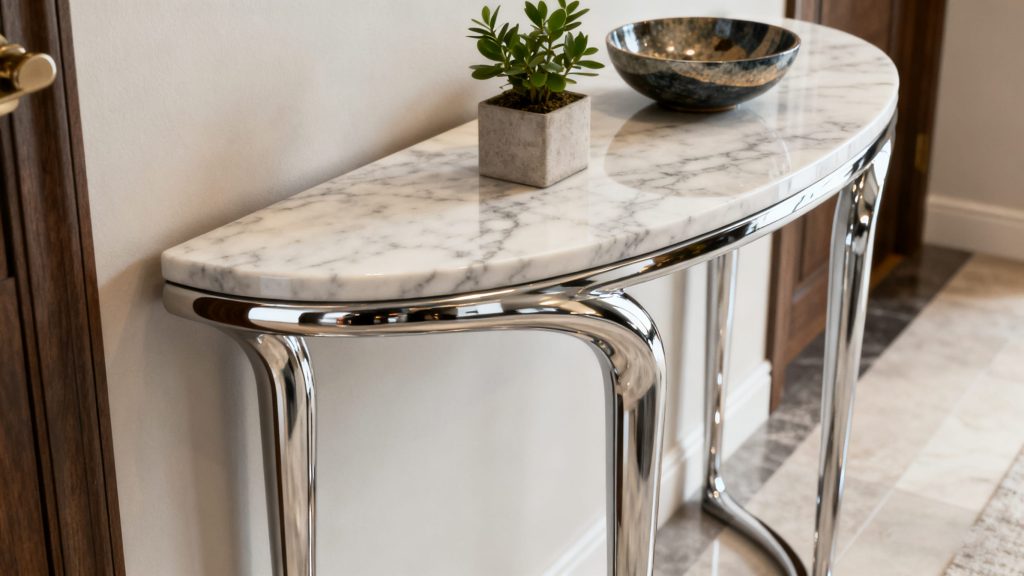
Types of Metals Used in Furniture Legs
Metal furniture legs come in various types, each with its own charm and characteristics:
- Steel: Known for its strength and durability. Perfect for heavy-duty furniture.
- Aluminum: Lightweight and resistant to rust, making it ideal for modern designs.
- Brass: Offers a touch of elegance and is often used in decorative furniture legs.
- Iron: Provides an industrial feel, often seen in vintage or rustic styles.
Benefits of Metal Furniture Legs
The advantages of opting for metal over wooden furniture legs are numerous:
- Durability: Metal is less prone to bending or breaking compared to wood.
- Versatility: They can complement various styles from industrial to contemporary.
- Maintenance: Easy to clean and maintain, requiring minimal effort to keep them looking good.
- Adjustable Options: Many metal legs come with adjustable features, perfect for uneven floors!
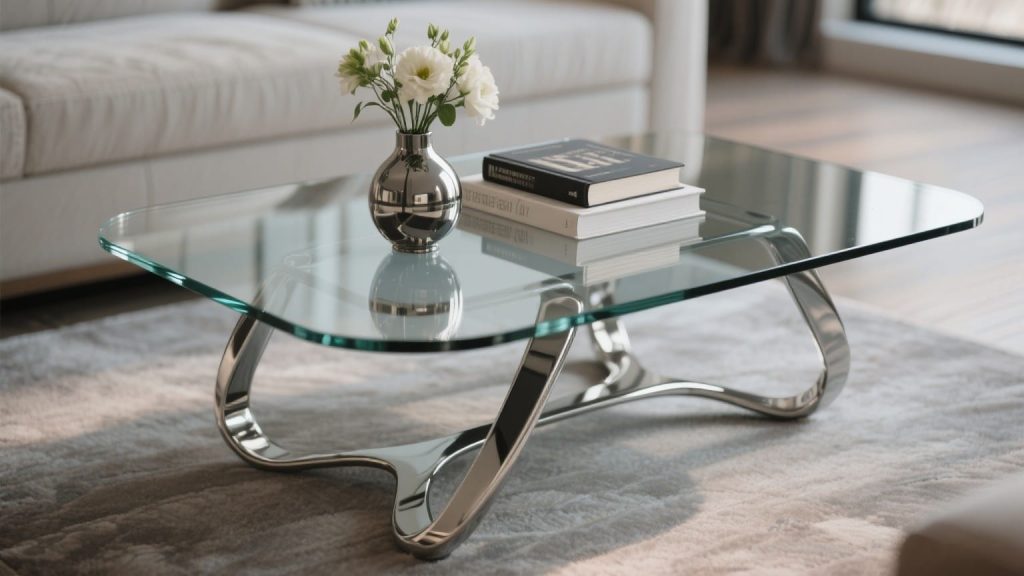
Popular Styles: Industrial, Modern, and Antique Options
The style of your metal furniture legs can dramatically influence the overall look of your piece. Here are some popular trends:
- Industrial Furniture Legs: Think raw finishes and rugged designs that scream character.
- Modern Furniture Legs: Sleek lines and minimalist aesthetics that fit perfectly in contemporary spaces.
- Antique Furniture Legs: Ornate designs that add a vintage touch perfect for those who love nostalgia!
Did you know? The global furniture market size was valued at USD 509.8 billion in 2020 and is expected to grow at a compound annual growth rate (CAGR) of 5.4% from 2021 to 2028. This growth reflects the increasing demand for innovative designs like metal furniture legs!
No matter what your design preferences are, exploring metal furniture legs opens up a world of possibilities. From heavy-duty options that can support your heaviest dining table to sleek modern designs that elevate your living room aesthetic, there’s something out there for every style. So go ahead mix it up!
Diving into Wooden Furniture Legs
When it comes to furniture legs, wooden options are like the classic rock of the furniture world timeless, versatile, and always in style. Let’s dig into the various aspects of wooden furniture legs that make them a favorite among designers and homeowners alike.
Types of Wood Commonly Used for Furniture Legs
- Oak: Known for its durability and beautiful grain, oak is a go-to for many furniture makers.
- Maple: This hardwood is prized for its fine, consistent grain and strength perfect for those heavy-duty dining table legs.
- Pine: A softer wood that’s budget-friendly and easily customizable; great for DIY furniture legs!
- Walnut: With its rich color and luxurious feel, walnut adds an elegant touch to any piece.
Advantages of Wooden Furniture Legs
- Aesthetic Appeal: Wooden legs can bring warmth and character to any room, making them ideal for both modern and traditional designs.
- Customizability: They can be easily stained or painted to match your specific decor style.
- Sustainability: Many wood options are sourced from sustainable forests, making them an eco-friendly choice.
- Stability: Solid wood offers excellent support, especially important for larger pieces like sofas or dining tables.
Design Considerations: Mid-Century, Contemporary, and Traditional Styles
The style of wooden furniture legs can significantly influence the overall look of your piece. Here’s how different styles play out:
- Mid-Century Modern: Think tapered legs that elevate your furniture while adding a retro flair. These are perfect for sofas or coffee tables!
- Contemporary: Sleek lines with minimalistic designs often feature square or round wooden legs that blend seamlessly with modern aesthetics.
- Traditional: Look for ornate details or turned styles in antique furniture legs that evoke a sense of history and craftsmanship.
Pro Tip: When selecting wooden furniture legs, consider not only the type of wood but also the finish. A matte finish can give a rustic vibe while a glossy finish screams modern elegance!
Diving into the world of wooden furniture legs opens up endless possibilities. Whether you’re crafting a new piece or replacing old parts, understanding the types of wood available will help you make informed choices that enhance both functionality and aesthetic appeal. So grab your tools (or reach out to us) and let’s get legging!
The Art of Mixing and Matching Furniture Legs Metals and Woods in Design
Mixing metals and woods in furniture design is like crafting the perfect playlist—it requires a keen ear for harmony and a dash of boldness to create something truly memorable. When it comes to furniture legs, this art form can elevate your pieces from ordinary to extraordinary.
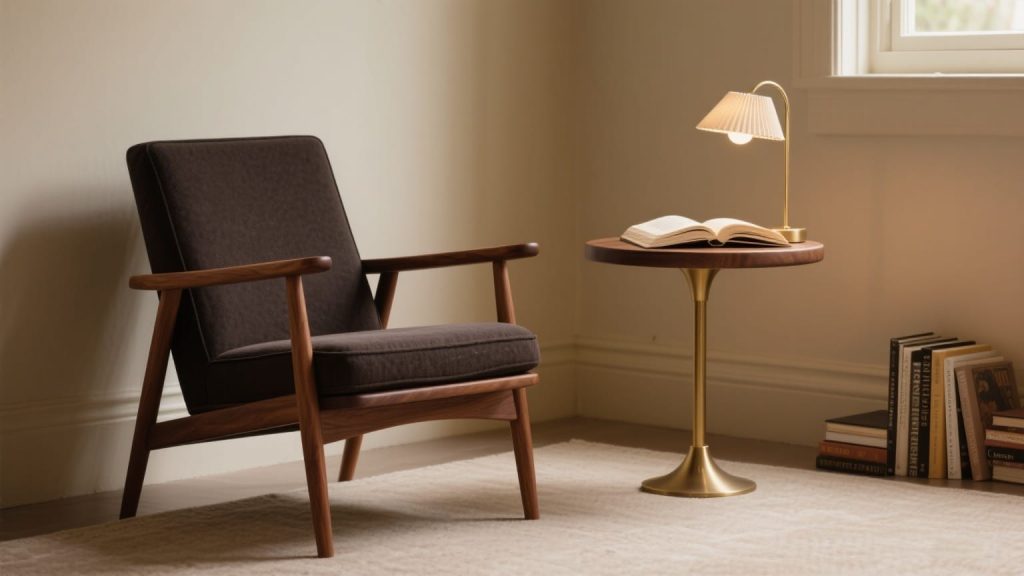
Complementary Color Schemes and Finishes
First things first: let’s talk color. Pairing warm wooden furniture legs with cool metal accents can create a stunning visual contrast. Think of rich walnut chair legs with sleek stainless steel table legs; it’s like peanut butter meeting chocolate—a match made in design heaven!
Balancing Textures and Shapes for Aesthetic Appeal
Texture is where the magic happens! Mixing smooth metal finishes with the grainy texture of wooden furniture legs adds depth to your design. For instance, combining decorative furniture legs made from iron with a reclaimed wood coffee table creates an inviting rustic vibe while keeping it modern.
Cohesion in Design: Maintaining a Unified Look Across Pieces
While mixing materials can be exciting, cohesion is key. Aim for a unified look by selecting metals and woods that share similar undertones or finishes. For example, if you have brass dining table legs, consider using wooden chair legs that have been stained to reflect the same warmth. This creates a seamless flow throughout your space.
Quick Tip: When designing with mixed materials, always consider the overall theme of your space—whether it’s industrial chic or mid-century modern—to ensure your pieces complement one another beautifully.
Incorporating Smart and Eco-Friendly Materials
In 2025, consider incorporating smart materials that can adjust to environmental conditions or user preferences. For example, legs made from smart alloys that can change color or texture based on temperature or touch. Additionally, using eco-friendly materials like bamboo or recycled metals not only reduces environmental impact but also adds a modern, sustainable touch to your design.
As you experiment with different combinations, remember that mixing metals and woods is not just about aesthetics; it’s also about functionality. For instance, adjustable furniture legs can offer both style and practicality, allowing you to adapt your pieces as needed without sacrificing design integrity.
In conclusion, mastering the art of mixing metals and woods in furniture leg design opens up endless possibilities for creativity. So go ahead, let your imagination run wild! You might just create the next trend in contemporary decor.
Practical Tips for Designers on Mixing Materials
Mixing materials in furniture design is like crafting a perfect cocktail—it requires the right ingredients in just the right proportions. Here are some practical tips to ensure your furniture legs, whether they be table legs, chair legs, or sofa legs, are both functional and fabulous!
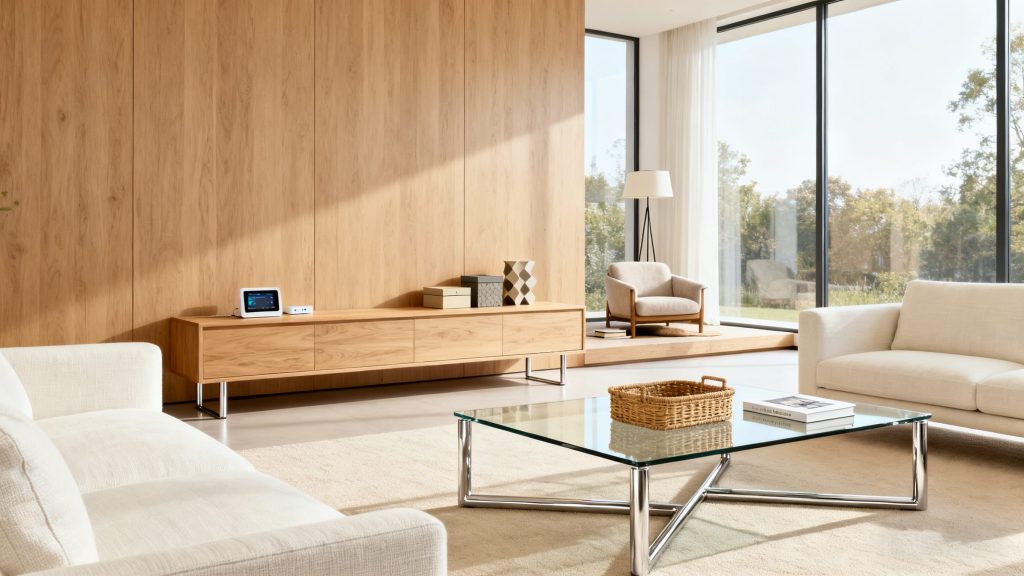
- Selecting the Right Combination: When choosing materials, consider the specific type of furniture you’re designing. For example, pairing sleek metal furniture legs with a rustic wooden table can create a stunning contrast. Think about how these combinations will enhance the overall aesthetic. Additionally, consider using smart materials that can adapt to different conditions, such as legs that adjust height automatically.
- Durability and Functionality: Don’t just focus on looks; think about how your choices affect durability. For instance, if you’re designing a sofa with adjustable furniture legs, ensure they can withstand daily use without sacrificing style. Heavy-duty options like iron furniture legs might be ideal for high-traffic areas. In 2025, also consider materials that are not only durable but also eco-friendly, such as bamboo or recycled metals.
- Sourcing Custom Options: Embrace creativity by exploring OEM solutions for unique designs. Custom options allow you to craft pieces that truly stand out. Whether you are after decorative furniture legs or something more industrial, there’s a world of possibilities waiting for your imagination. Consider using smart materials that can be customized to specific user preferences, such as legs that change color or texture based on touch.
- Color and Finish Coordination: Ensure that the finishes of your materials complement each other. A matte black metal leg can beautifully offset a glossy walnut wooden leg, creating depth and interest in your design. In 2025, also consider finishes that are not only aesthetically pleasing but also functional, such as antimicrobial coatings or self-healing surfaces.
- Avoiding Common Misconceptions: One common mistake is assuming that mixing metals will clash. In fact, when done thoughtfully, it can create a layered look that adds character to your piece. Try combining brass and stainless steel for an unexpected twist! Additionally, avoid the misconception that smart materials are too complex to use; many are designed to be user-friendly and can greatly enhance the functionality of your furniture
- Experiment with Shapes: Don’t shy away from mixing different shapes of furniture legs. Pairing round and square shapes can add an intriguing visual element to your design while maintaining harmony through consistent material choices. In 2025, consider how smart materials and eco-friendly options can enhance these shape combinations, creating not only a visually appealing but also a sustainable and functional piece.
Takeaway: Mixing materials isn’t just about aesthetics; it’s about creating functional art that tells a story through its design elements. So go ahead, mix those metals and woods but do it wisely! Consider the latest trends in smart materials, eco-friendly options, and customizable designs to ensure your pieces are both beautiful and functional.
Current Trends in Furniture Leg Design (2025)
As we step into 2025, the realm of furniture legs continues to evolve with fresh ideas and cutting-edge designs. Interior designers worldwide are pushing boundaries, and here’s what’s currently trending:
Analysis from Top Designers: The design landscape now emphasizes the seamless integration of functionality, aesthetics, and technology. Designers are exploring how table legs, chair legs, and sofa legs can not only enhance a piece’s appearance and durability but also incorporate smart features.
Emerging Styles:
- Smart and Adaptive Legs: With the rise of smart home technology, furniture legs are becoming smarter too. Legs with built-in sensors can adjust height and angle based on user preferences or room conditions, offering unparalleled comfort and convenience.
- Eco-Friendly and Biodegradable Materials: Sustainability remains a top priority. Designers are increasingly using biodegradable materials like bamboo, cork, and mycelium-based composites. These materials not only reduce environmental impact but also add a natural, organic feel to furniture.
- Minimalist and Modular Designs: Clean lines and modular concepts are in vogue. Furniture legs that allow for easy disassembly and reconfiguration are popular, catering to the modern consumer’s need for flexibility and space optimization.
- Fusion of Traditional and Modern: There’s a growing trend of blending traditional craftsmanship with modern design elements. For example, combining hand-carved wooden legs with sleek metal accents creates a unique, timeless look.
- Personalization and Customization: Consumers are seeking highly personalized furniture. Customizable furniture legs, where users can choose from a variety of materials, finishes, and styles, are becoming the norm.
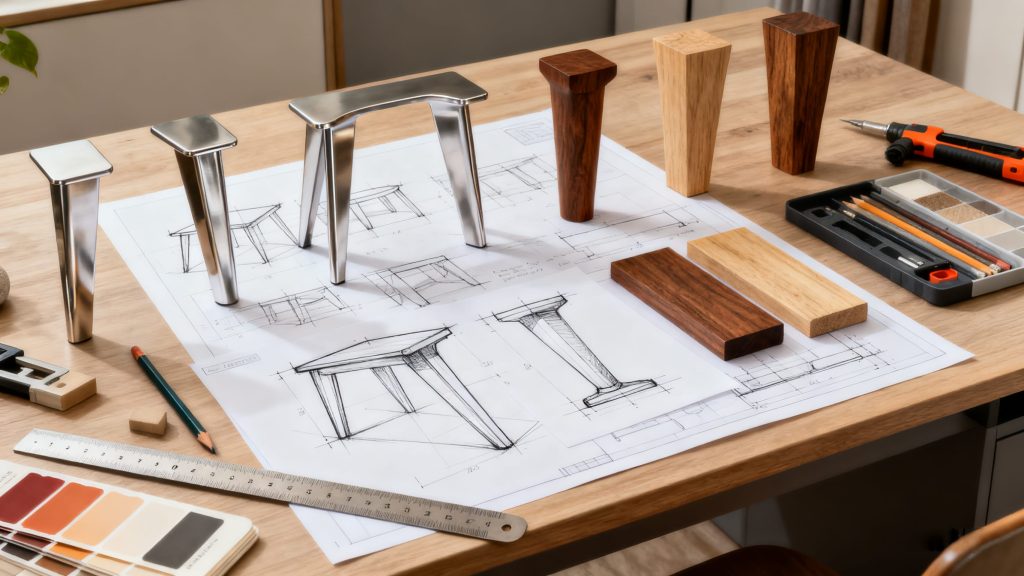
Key Takeaway: The future of furniture legs is a blend of innovation, sustainability, and personalization. Staying informed about these trends will help you create pieces that not only meet today’s consumer demands but also anticipate future needs. Whether you opt for smart adaptive legs or eco-friendly materials, the key is to create furniture that is both functional and beautiful.
The Role of Quality in Furniture Leg Manufacturing
When it comes to furniture legs, quality is not just a nice-to-have; it’s a must-have. Think of it as the unsung hero of your furniture design. Without sturdy, reliable legs, your beautiful table or stylish sofa could easily end up wobbling like a toddler on roller skates.
Quality assurance in production processes ensures that every piece meets rigorous standards, which is crucial for maintaining the integrity of your furniture. After all, nobody wants to deal with a coffee table that collapses under the weight of their favorite books or a dining table that can’t hold its own during family gatherings!
- Importance of quality assurance in production processes:
- Ensures durability and longevity of furniture legs
- Reduces the risk of defects and failures
- Enhances customer satisfaction and brand reputation
- ISO certification significance:
- Demonstrates commitment to quality and safety standards
- Provides a competitive edge in the marketplace
- Facilitates smoother international trade by meeting global standards
- Mitigating risks through reliable supply chains:
- Sourcing materials from trusted suppliers minimizes variability
- Establishing strong relationships with manufacturers ensures consistent quality
- A well-managed supply chain can adapt quickly to market demands, keeping you ahead of trends.
The bottom line? Investing in quality manufacturing processes for your furniture legs not only protects your products but also elevates your brand’s reputation. It’s like building a solid foundation for a house; without it, everything else is at risk. So whether you’re looking at wooden furniture legs or metal options like stainless steel or brass, remember: quality first!
- ISO certification significance
- Mitigating risks through reliable supply chains
Conclusion
As we bring this comprehensive guide to a close, let’s summarize the key takeaways and reinforce the core concepts we’ve explored:
Recap of Key Points
- Material Selection: Choosing between metal and wooden furniture legs is crucial. Metal legs offer durability and a modern aesthetic, while wooden legs bring warmth and timeless elegance.
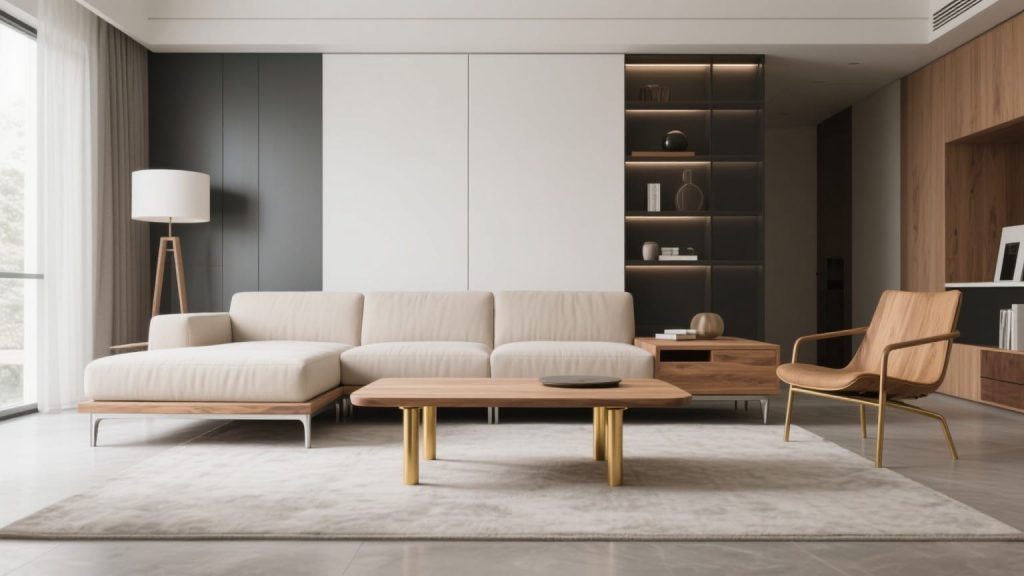
- Mixing Materials: Combining metals and woods can create stunning visual contrasts. Focus on complementary colors, balanced textures, and cohesive design to achieve harmony.
- Current Trends: Stay ahead with trends like hairpin legs, tapered designs, and sustainable materials. These trends reflect modern preferences for both style and eco-consciousness.
- Quality Assurance: Prioritize quality in manufacturing to ensure durability, reduce defects, and enhance customer satisfaction. ISO certifications and reliable supply chains are vital.
Encouragement to Experiment
- Be Bold: Don’t be afraid to mix different materials and styles. The right combination can transform your space and create unique, eye-catching designs.
- Stay Informed: Keep up with the latest trends and innovations in furniture design. This knowledge will help you create pieces that resonate with today’s consumers.
- Quality First: Always prioritize quality in your designs. Reliable manufacturing processes and materials ensure that your furniture not only looks great but also stands the test of time.
Invitation to Collaborate
- Custom Solutions: We invite you to collaborate with us for custom furniture leg designs that reflect your unique vision and style. Whether you’re a designer or a homeowner, our expertise can help bring your ideas to life.
- Let’s Create Together: Reach out to us to discuss your project and explore how we can work together to create standout pieces that combine functionality with beauty.
In summary, mastering the art of mixing metals and woods in furniture leg design opens up endless possibilities for creativity. By understanding the basics, exploring diverse options, and prioritizing quality, you can craft pieces that are both functional and beautiful. So, go ahead and experiment—let’s create something extraordinary together!
